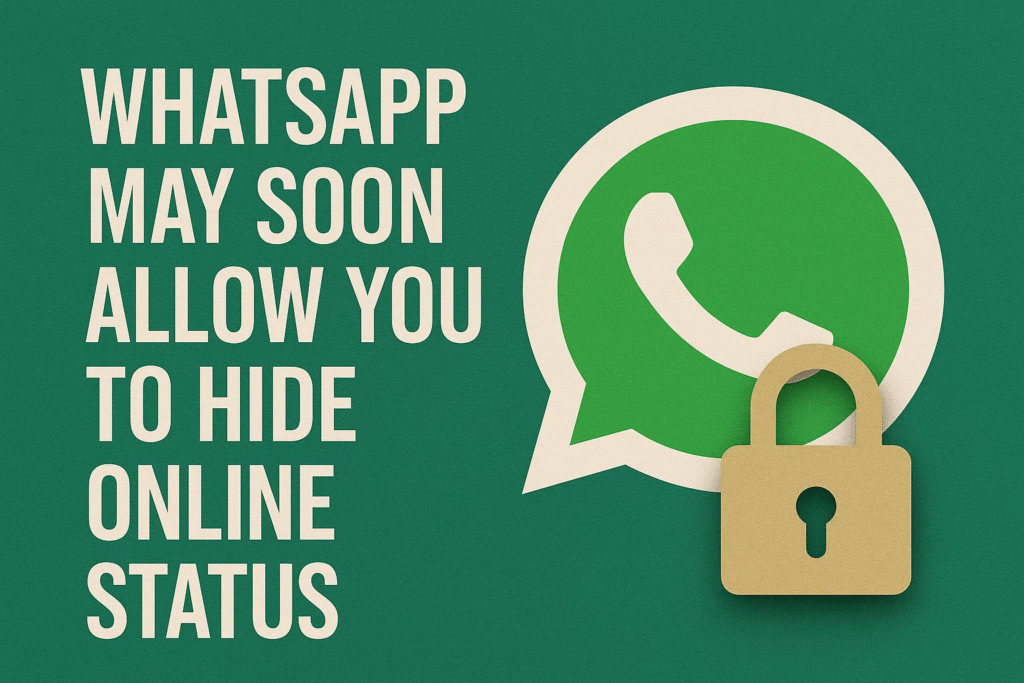In today’s digital era, privacy has become one of the most discussed and demanded aspects of online communication. Whether it’s social media, email, or instant messaging, users crave more control over who can see their activities and when. Among all the popular messaging platforms, WhatsApp has always been at the forefront of offering user-friendly privacy features — from read receipts to last seen control.
And now, one of the most awaited updates seems to be on its way — the ability to hide your “online” status.
This new feature has already sparked excitement among users worldwide. Imagine being able to chat, scroll, or reply to messages without anyone knowing you’re online! It’s a small but powerful addition that redefines how we manage our digital privacy.
In this blog, we’ll explore what this upcoming feature means, how it works, why it matters, and how it fits into the larger picture of WhatsApp’s evolution. We’ll also take a look at how users can prepare for it and what other privacy-related updates are in development.
Why Privacy Matters More Than Ever
Before diving into WhatsApp’s new update, it’s essential to understand why privacy features like these are becoming increasingly significant.
Over the years, digital communication has evolved from personal messaging to real-time social interaction. With this evolution, the boundary between online availability and personal space has blurred. Users often feel pressured to respond instantly when someone sees them online, even if they’re not in the mood to chat.
This constant visibility can cause stress and even lead to digital fatigue. As a result, platforms like WhatsApp are now realizing that privacy is not just about data security — it’s about emotional comfort and personal space.
The Evolution of WhatsApp Privacy Features
Let’s take a quick look at how WhatsApp has gradually enhanced its privacy tools over time.
| Year | Feature Introduced | Description |
|---|---|---|
| 2014 | Last Seen Control | Allowed users to hide their “last seen” time from contacts. |
| 2016 | End-to-End Encryption | Ensured that only the sender and receiver can read the messages. |
| 2017 | Two-Step Verification | Added an extra layer of security for account protection. |
| 2020 | Disappearing Messages | Messages automatically deleted after a set time. |
| 2021 | View Once Media | Photos and videos could be viewed only once. |
| 2022 | Hide Last Seen From Specific Contacts | More control over who can view activity status. |
| 2023-2025 (Testing) | Hide Online Status | Users can appear offline even when they’re using WhatsApp. |
This timeline clearly shows WhatsApp’s steady commitment to improving user privacy and control.
What Does “Hide Online Status” Mean?
When you open WhatsApp and connect to the internet, your contacts can see the “online” tag below your name. It indicates that you’re active and using the app.
However, with the new “Hide Online Status” option, users can choose to appear offline even when they are using the app. This means that:
-
You can read and reply to messages privately.
-
No one will know that you’re currently online.
-
You’ll still have full access to all WhatsApp features without exposing your activity.
It’s similar to being “invisible mode” on messaging platforms like Skype or Telegram.
How the Feature Works
According to reports from WhatsApp beta testers, this feature is likely to be integrated into the Privacy Settings section. Here’s what it may look like:
-
Open Settings → Privacy → Last Seen & Online.
-
You’ll find two options:
-
Who can see my Last Seen?
-
Who can see when I’m Online?
-
-
For the “Online” status, you’ll have two choices:
-
Everyone
-
Same as Last Seen
-
So, if your Last Seen is visible to “Nobody,” your Online status will also be hidden from everyone.
This approach ensures that both settings work together seamlessly, maintaining consistency across WhatsApp’s privacy features.
Why This Feature Is a Game-Changer
There are several reasons why this simple update could transform how people use WhatsApp:
1. Improved Privacy Control
Users finally get complete control over their visibility. They can chat or check messages freely without being pressured to respond immediately.
2. Reduced Social Pressure
People often feel obligated to reply just because others can see they’re online. By hiding your status, you can maintain personal boundaries.
3. Safer for Professionals and Businesses
For business owners or customer service agents using WhatsApp, this feature can help them manage work-life balance by going “invisible” when off duty.
4. Better Mental Health
Constant online availability can be mentally exhausting. This feature offers peace of mind and helps users disconnect when needed.
Comparison: Old vs. New Privacy Controls
| Privacy Option | Before the Update | After the Update (Expected) |
|---|---|---|
| Last Seen | Can hide from everyone or specific contacts | Same functionality retained |
| Online Status | Visible to everyone once you open the app | Can be hidden (linked with Last Seen) |
| Read Receipts | Optional blue ticks for seen messages | Remains unchanged |
| Typing Indicator | Always visible when typing | Still visible but may get future toggle option |
| Profile Photo Visibility | Can be hidden from specific contacts | No major change expected |
This table clearly shows that WhatsApp is not just tweaking old settings but expanding the depth of user privacy control.
Reactions from Users
Social media discussions show that this feature is being widely welcomed. Many users have shared their excitement, saying it will finally let them use WhatsApp without feeling watched.
Some people use WhatsApp purely for communication convenience — not to broadcast their online habits. So, the ability to hide the online tag gives users more comfort, especially in sensitive or professional situations.
Impact on Personal and Professional Use
For Personal Users
-
Helps maintain privacy in relationships or friendships.
-
Reduces unnecessary conflicts like “You were online but didn’t reply.”
-
Encourages more mindful and less reactive messaging.
For Professionals
-
Allows employees to check messages discreetly.
-
Helps freelancers and entrepreneurs maintain client boundaries.
-
Prevents the impression of being available 24/7.
In both cases, this small change brings a big psychological benefit — the freedom to use WhatsApp on your own terms.
How to Enable the Feature (Once Released)
When the feature becomes publicly available, here’s how you’ll likely activate it:
-
Open WhatsApp.
-
Go to Settings → Account → Privacy.
-
Tap on Last Seen & Online.
-
Under “Who can see when I’m online,” choose Same as Last Seen.
-
If your Last Seen is set to “Nobody,” your online status will also be hidden.
That’s it — you’re now invisible while still fully active on WhatsApp!
The Future of Privacy on WhatsApp
This update fits into a broader privacy roadmap that WhatsApp has been pursuing. The platform is gradually shifting from open visibility to personalized privacy.
Here are some upcoming or rumored privacy features being tested or discussed:
| Feature Name | Purpose | Expected Launch |
|---|---|---|
| Stealth Mode for Calls | Hide online activity during calls. | 2025 |
| Custom Privacy Groups | Set different privacy levels for different contact lists. | 2025 |
| Auto-Invisible Mode | Automatically go offline after inactivity. | TBD |
| Temporary Status Visibility | Show online status to selected people for a limited time. | TBD |
These developments show that WhatsApp is not stopping here — it’s moving toward a more user-controlled and privacy-focused future.
Comparison with Other Apps
Let’s see how WhatsApp’s new privacy control stacks up against other major messaging platforms:
| Platform | Can Hide Online Status? | Other Privacy Features |
|---|---|---|
| Coming soon | End-to-end encryption, disappearing messages | |
| Telegram | Yes | Secret chats, self-destructing messages |
| Signal | Yes | Screen security, relay calls |
| Messenger | Partially | Active status toggle |
| iMessage | No | Limited visibility control |
From this comparison, WhatsApp is finally catching up with competitors like Telegram and Signal, who already offer similar “invisible” features.
Potential Drawbacks and Concerns
While the feature is widely appreciated, it’s worth noting a few possible downsides:
-
Reduced Transparency
-
Friends or family might misunderstand why you appear offline.
-
-
More Miscommunication
-
People might assume you’re ignoring them if they can’t see your status.
-
-
Limited Use in Some Cases
-
Users who rely on online status to track availability (like business accounts) might find it less convenient.
-
However, these are minor concerns compared to the benefits of personal privacy.
WhatsApp’s Broader Vision
WhatsApp’s parent company, Meta, has been working across all its platforms — including Facebook and Instagram — to provide better privacy management tools. The idea is to make users feel safe, comfortable, and in control of their digital presence.
This new feature aligns with Meta’s focus on “private messaging first.” Instead of pushing users toward open public interaction, the company is prioritizing features that make private communication safer and more flexible.
User Reactions and Social Impact
Early reactions on tech forums and social platforms reveal interesting insights:
-
Many users consider it a mental health-friendly update.
-
Parents appreciate being able to monitor chats discreetly without being visible.
-
Some businesses plan to use it strategically to appear less accessible during non-working hours.
This shows that hiding online status isn’t just about secrecy — it’s about choice and balance in a hyper-connected world.
How This Affects WhatsApp’s User Experience
By allowing people to appear offline, WhatsApp is redefining what it means to be “active.”
In the past, online activity was automatically visible — giving a sense of openness but also intrusiveness. Now, users can shape how they’re perceived.
It also enhances asynchronous communication, meaning you can respond when you’re ready rather than feeling pressured to chat instantly.
This aligns perfectly with modern digital habits — more privacy, less pressure, and better control.
Tips for Using the Feature Wisely
-
Use It Selectively: Hide your status only when needed to maintain balance.
-
Communicate Boundaries: Let close contacts know if you prefer not to show online activity.
-
Combine with Other Settings: Use disappearing messages and read receipts together for stronger privacy.
-
Avoid Misuse: Don’t use invisibility to ignore or mislead others intentionally.
When used properly, this feature can significantly enhance your overall WhatsApp experience.
The Psychology Behind “Invisible Mode”
Humans naturally seek both connection and independence. Being constantly visible online satisfies the need for connection but can harm independence and mental peace.
The ability to hide your online status restores psychological autonomy — the freedom to choose when and how to engage.
This simple option can actually reduce stress, improve relationships, and encourage healthier digital habits.
What Users Should Expect Next
As WhatsApp continues to evolve, users can expect even more customizable features related to privacy, notifications, and control.
In the coming updates, we might see:
-
“Offline replies” (send messages without showing online).
-
“Scheduled availability” (choose when to appear online).
-
“Private mode” for group chats.
These innovations point toward a future where privacy and flexibility become central to every digital interaction.
Conclusion
The upcoming feature allowing users to hide their online status on WhatsApp marks a significant step forward in digital privacy. It acknowledges the modern reality that users want to stay connected — but on their own terms.
By offering this feature, WhatsApp is giving users more freedom, comfort, and control than ever before. Whether you’re using the app for personal communication, professional networking, or family updates, this update ensures your privacy remains intact.
In a world where online presence often dictates social expectations, being able to choose when to appear “online” is not just a technical upgrade — it’s a cultural shift toward mindful communication.
As privacy becomes the new currency of trust, WhatsApp’s move could set a benchmark for all future messaging platforms.


